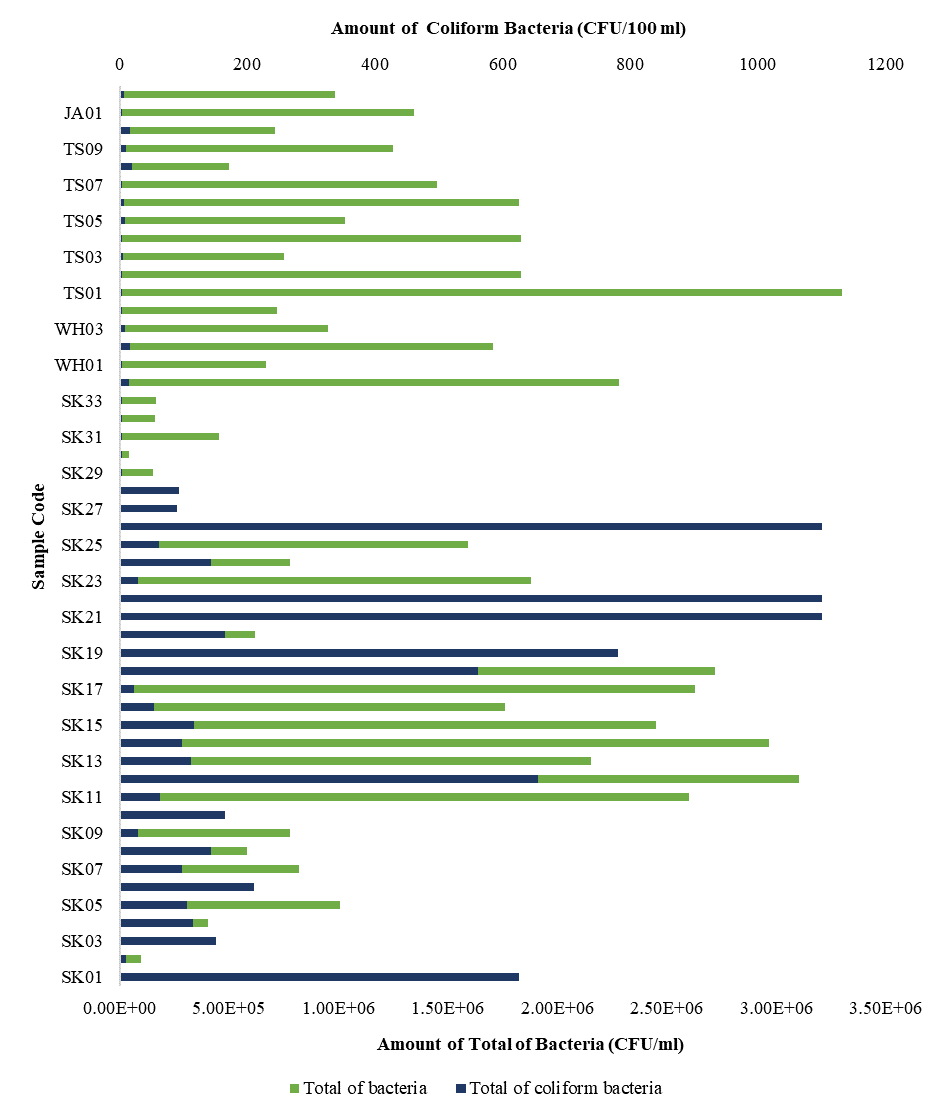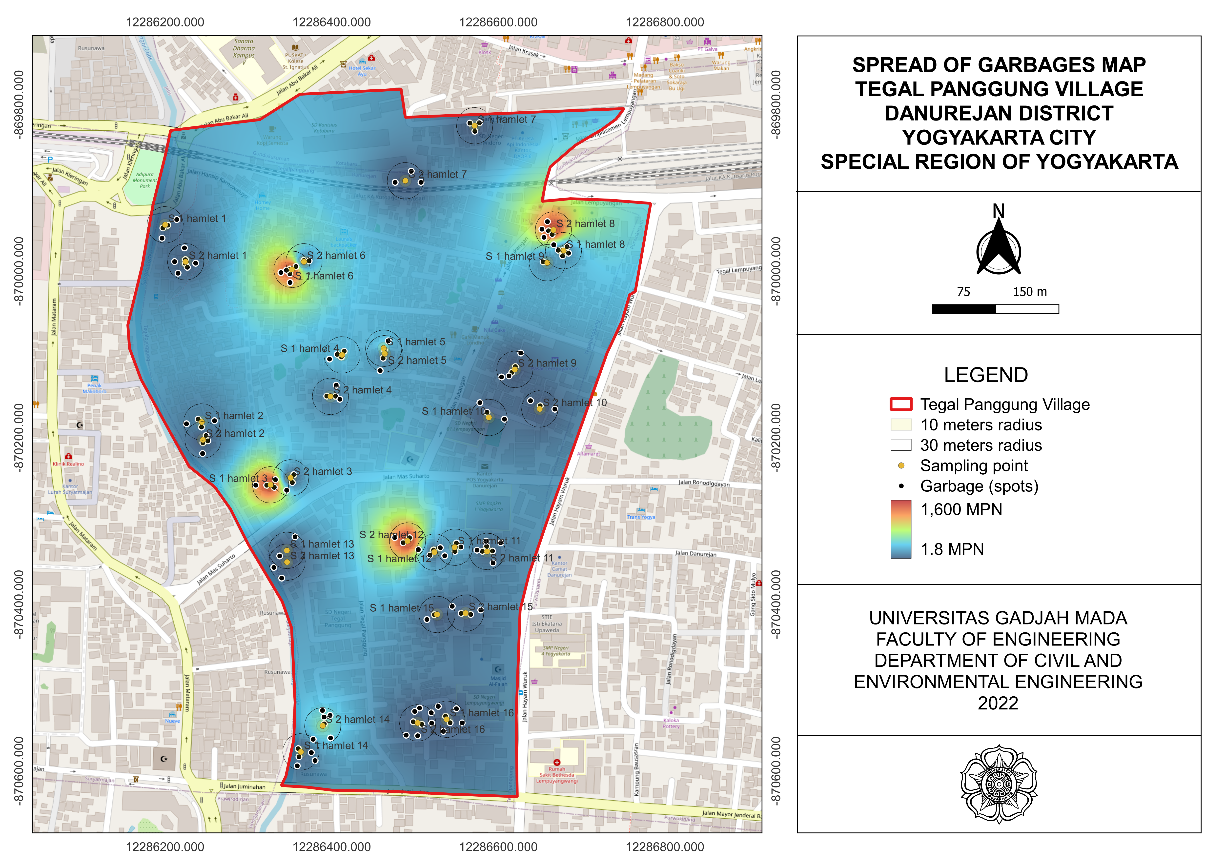The Potential Risk of Hearing Loss on Noise-Exposed Housewives : An Observational Study at Sukosari Madiun Railway Residentia
Downloads
Introduction: Hearing loss events often occur in communities who exposed to high-intensity noise and for long periods. Residents who lived around the railway tracks had a high risk of experiencing hearing loss. This study aims to analyze the potential risk of hearing loss in housewives who for 1x24 hours was always exposed to train noise.Method: This research was an observational analytic study with a cross-sectional design. The sample of this study was 42 housewives who were divided into 2 groups: 21 people exposed to noise and 21 people not exposed to noise. Respondents were selected using a simple random sampling technique. Research data obtained through interviews and observations. Measurement of noise intensity using a whisper test. Result and Discussion: Measurement of day and night noise (L = 65,9 dBA) has exceeded the noise quality standard set for residential areas which were 55 dBA. The results showed that noise (p = 0,030; OR = 5,846) had a strong correlation with hearing loss. While age (p = 0,416), length of stay (p = 1,000), the presence of a barrier (p = 0,465) did not have a significant correlation with hearing loss. Conclusion: Housewives who were exposed to noise have the potential risk of hearing loss. Therefore, efforts must be made to adjust the distance of the settlement and the installation of sound dampers to reduce the risk of hearing loss.
Suyono. Pencemaran Kesehatan Lingkungan. Jakarta: EGC; 2014.
Suryani NDI. Hubungan Kebisingan dan Umur dengan Tekanan Darah Ibu Rumah Tangga di Pemukiman Jalan Ambengan Surabaya. Jurnal Kesehatan Lingkungan. 2017;10(1):70–81. http://dx.doi.org/10.20473/jkl.v10i1.2018.70-81.
Christi FV. Hubungan Paparan Bising Kereta Api dengan Gangguan Pendengaran dan Gangguan Non Auditori Penduduk Sepanjang Rel Ngagel Rejo Surabaya. Skripsi. Surabaya: Universitas Airlangga; 2016.
WHO. Burden of Disease from Environmental Noise : Quantification of Healthy Life Years Lost in Europe. Geneva: WHO Regional Office for Europe; 2011.
WHO. WHO Global Estimates on Prevalence of Hearing Loss. 2012. http://www.who.int/pbd/deafness/WHO_GE_HL.pdf.
Brown AL, van Kamp I. WHO environmental noise guidelines for the European region: A systematic review of transport noise interventions and their impacts on health. International Journal of Environmental Research and Public Health. 2017;14(8):1–44. https://doi.org/10.3390/ijerph14080873.
Kementerian Lingkungan Hidup Republik Indonesia. Keputusan Menteri Negara Lingkungan Hidup Nomor Kep-48/MENLH/11/1996 tentang Baku Tingkat Kebisingan.
Pusat Sarana Pengendalian Dampak Lingkungan. Laporan Pengkajian dan Pemantauan Kebisingan Lingkungan di Sekitar Lintasan Kereta Api. Jakarta: Kementerian Lingkungan Hidup RI; 2013.
Tikka C, Verbeek JH, Kateman E, Morata TC, Dreschler WA, Ferrite S. Interventions to Prevent Occupational Noise-induced Hearing Loss. Cochrane Database of Systematic Reviews. 2017. https://doi.org/10.1002/14651858.CD006396.pub4.
Sasmit A, Andrio D. Evaluasi Tingkat Kebisingan di Bandara Sultan Syarif Kasim II Pekanbaru. Jurnal Teknik UNIPA. 2017;15(1):30-35. http://jurnal.unipasby.ac.id/index.php/waktu/article/view/441.
Fink D. What Is a Safe Noise Level for the Public?. American Journal of Public Health. 2017;107(1): 44-45. https://doi.org/10.2105/AJPH.2016.303527.
Mirza R, Kirchner D, Dobie RA, Crawford J. Occupational Noise-Induced Hearing Loss. Journal of Occuppational and Environmental Medicine. 2018;60(9):498–501. https://doi.org/10.1097/JOM.0000000000001423.
Hernayanti M, Joko T, Dangiran H. Hubungan Kebisingan di Bandara Halim Perdanakusuma Jakarta Timur terhadap Gangguan Non-Auditori Permukiman Penduduk Wilayah Buffer. Jurnal Kesehatan Masyarakat. 2018;6(6):214–224. https://ejournal3.undip.ac.id/index.php/jkm/article/view/22179.
Basner M, Babisch W, Davis A, Brink M, Clark C, Janssen S, et al. Auditory and non-auditory effects of noise on health. The Lancet Journal. 2014;383(9925):1325–1332. https://dx.doi.org/10.1016%2FS0140-6736(13)61613-X.
Lundine JP, McCauley RJ. A Tutorial on Expository Discourse: Structure, Development, and Disorders in Children and Adolescents. American Journal of Speech-Language Pathology. 2016;25(3): 306-320. https://pubs.asha.org/10.1044/2016_AJSLP-14-0130.
Lubis F, Annisa R. Hubungan Paparan Kebisingan Dan Karakteristik Individu dengan Kelainan Tekanan Darah Pengemudi Becak Bermotor di Kecamatan Medan Johor Kota Medan Tahun 2017. Jurnal Kesehatan Masyarakat & Gizi (JKG). 2018;1(1):17-22. https://doi.org/10.35451/jkg.v1i1.69
Mukhlish WIN, Sudarmanto Y, Hasan M. Pengaruh Kebisingan Terhadap Tekanan Darah dan Nadi pada Pekerja Pabrik Kayu PT. Muroco Jember. Jurnal Kesehatan Lingkungan Indonesia. 2018;17(2):112-118. https://doi.org/10.14710/jkli.17.2.112-118
Widya M, Setiani O, Dangiran H. Hubungan Intensitas Kebisingan Dengan Tekanan Darah Sistolik Dan Diastolik pada Pekerja Pertambangan Pasir dan Batu PT. X Rowosari, Semarang. Jurnal Kesehatan Masyarakat. 2018;6(6):225 - 234. https://ejournal3.undip.ac.id/index.php/jkm/article/view/22180.
Jin S, Kim M, Park S, Park S. Stress Hormonal Changes in the Brain and Plasma After Acute Noise Exposure in Mice. Auris Nasus Larynx. 2017;44(3):272-276. https://www.ncbi.nlm.nih.gov/pubmed/27496010
Saraswati E. Pengaruh Kebisingan Kereta Api terhadap Kenaikan Denyut Nadi dan Gangguan Komunikasi pada Masyarakat di Kelurahan Sukosari Kecamatan Kartoharjo Madiun. Study Report. Surabaya: Politeknik Kesehatan Kementerian RI; 2016.
Basner M, McGuire S. WHO Environmental Noise Guidelines for The European Region: A Systematic Review on Environmental Noise and Effects on sleep. Journal of Environmental Research and Public Health. 2018; 15(3):519. https://doi.org/10.3390/ijerph15030519.
Davis A, McMahon CM, Pichora-Fuller KM, Russ S, Lin F, Olusanya BO, et al. Aging and Hearing health: The Life-course Approach. Gerontologist. 2016;56(2):256-267. https://doi.org/10.1093/geront/gnw033.
Biberger T, Ewert S. The Effect of Room Acoustical Parameters on Speech Reception Threshold and Spatial Release from Masking. The Journal of the Acoustical Society of America. 2019;146(4):2188-2230. https://doi.org/10.1121/1.5126694.
Gilles A, Paul V. Effectiveness of a Preventive Campaign for Noise-Induced Hearing Damage in Adolescents. International Journal of Pediatric Otorhinolaryngology. 2014;78(4):604-609. https://doi.org/10.1016/j.ijporl.2014.01.009.
Fithri P. Analisis Intensitas Kebisingan Lingkungan Kerja pada Area Utilities Unit PLTD dan Boiler (Studi Kasus PT.Pertamina RU II Dumai). Jurnal Sains dan Teknologi Industri. 2015;12(2):278-285. http://ejournal.uin-suska.ac.id/index.php/sitekin/article/view/1057/1000.
Felantika J. Pengaruh Jarak Pemukiman terhadap Tingkat Kebisingan pada Jalur Kereta Api Jenis Ekonomi di Wilayah Kelurahan Winongo Kota Madiun. Madiun : Skripsi. Stikes Bakti Husada Mulia; 2018.
Arista E, Rili R. Desain Pembuatan Barrier Guna Mengurangi Kebisingan Kereta Api Akibat Double Track Jalur Kereta Api Di Area Pemukiman Lintas Manggarai-Bekasi. Jurnal Perkeretaapian Indonesia. 2017;1(2):97–104. https://jurnal.api.ac.id/index.php/jpi/article/view/36.
Ismail A, Shahid N, Nizam A. Development of Green Curtain Noise Barrier Using Natural Waste Fibres. Journal of Advanced Research Materials Science. 2016;17(1):1–9. https://www.researchgate.net/publication/306358990_Development_of_Green_Curtain_Noise_Barrier_Using_Natural_Waste_Fibres.
Erdianto A, Irwan S, Kastono D. Fungsi Ekologis Vegetasi Tanaman Denggung Sleman sebagai Pengendali Iklim Mikro dan Peredam Kebisingan. Vegetalika. 2019;8(3):139-152. https://doi.org/10.22146/veg.41374.
Hong J, Jeon J. The Effect of Audio Visual Factors on Perceptions of Environmental Noise Barrier Performance. Landscape and Urban Planning. 2014:28-37. https://doi.org/10.1016/j.landurbplan.2014.02.001.
Putra I, Rombang J, Nurmawan W. Analisis Kemampuan Vegetasi dalam Meredam Kebisingan. Eugenia. 2018;24(3):105-115. https://doi.org/10.35791/eug.24.3.2018.22660
Halim H, Abdullah R, Ali A, Nor M. Effectiveness of Existing Noise Barriers : Comparison Between Vegetation, Concrete Hollow Block, and Panel Concrete. Procedia Environmental Sciences. 2015;30:217-221. https://doi.org/10.1016/j.proenv.2015.10.039
Peraturan Pemerintah RI No 56 Tahun 2009 tentang Penyelenggaraan Perkeretaapian.
Putri WW, Martiana T. Hubungan Usia dan Masa Kerja dengan Nilai Ambang Dengar Pekerja yang Terpapar Bising di PT. X Sidoarjo. The Indonesian Journal of Occupational Safety and Health. 2016;5(2):173-182. http://dx.doi.org/10.20473/ijosh.v5i2.2016.173-182
Stucken E, Hong R. Noise-Induced Hearing Loss : An Occupational Medicine Perspective. Current Opinion in Otolaryngology & Head and Neck Surgery. 2014;22(5):388-393. https://doi.org/10.1097/MOO.0000000000000079.
Choi Y, Kim K. Noise-Induced Hearing Loss in Korean Workers: Co-Exposure to Organic Solvents and Heavy Metals in Nationwide Industries. PLOS One. 2014;9(5):e97538. https://doi.org/10.1371/journal.pone.0097538.
Rahayu P, Pawenang ET. Faktor yang Berhubungan Dengan Gangguan Pendengaran pada Pekerja yang Terpapar Bising di Unit Spinning I PT. Sinar Pantja Djaja Semarang. Unnes Journal of Public Health. 2016;5(2):140–148. https://doi.org/10.15294/ujph.v5i2.10122.
Desinta I, Andarani P, Budiawan W. Analisis Faktor Risiko Gangguan Pendengaran dan Estimasi Excess Risk Gangguan Pendengaran Akibat Paparan Kebisingan Pada Personel Kabin Masinis DAOP IV Semarang. Jurnal Teknik Lingkungan. 2017;6(4):1-11. https://ejournal3.undip.ac.id/index.php/tlingkungan/article/view/25238
Marisdayana R, Suhartono S, Nurjazuli N. Hubungan Intensitas Paparan Bising Dan Masa Kerja Dengan Gangguan Pendengaran Pada Karyawan PT. X. Jurnal Kesehatan Lingkungan Indonesia. 2016;15(1):22-27. https://doi.org/10.14710/jkli.15.1.22-27.
Septiana N, Widowati E. Gangguan Pendengaran Akibat Bising. HIGEA : Journal of Public Health Research and Development. 2017;1(1):73–82. https://journal.unnes.ac.id/sju/index.php/higeia/article/view/13993.
Saxena A. Noise Induced Hearing Loss in Indian Railway Loco Pilots: Are We Aware? Otolaryngology - Open Journal. 2018;4(2):18–21. https://doi.org/10.17140/otloj-4-148.
Moore D, Edmondson-Jones M, Dawes P, Fortnum H, McCormack A, Pierzycki R, et al. Relation Between Speech-in-Noise Threshold, Hearing Loss and Cognition from 40–69 Years of Age. PLOS One. 2014;9(9):1-10. https://doi.org/10.1371/journal.pone.0107720.
Liberman MC, Epstein MJ, Cleveland SS, Wang H, Maison SF. Toward A Differential Diagnosis Of Hidden Hearing Loss In Humans. PLOS One. 2016; 11(9): e0162726. https://doi.org/10.1371/journal.pone.0162726.
Tu NC, Friedman RA. Age-related hearing loss: Unraveling the pieces. Laryngoscope Investigative Otolaryngology. 2017;3(2):68–72. https://dx.doi.org/10.1002%2Flio2.134.
Lie A, Skogstad M, Johannessen HA, Tynes T, Mehlum IS, Nordby KC, et al. Occupational noise exposure and hearing: a systematic review. International Archives of Occupational and Environmental Health. 2016;89(3):351-372. https://doi.org/10.1007/s00420-015-1083-5.
Royster JD. Preventing Noise-Induced Hearing Loss. North Carolina Medical Journal. 2017;78(2):113–117.https://doi.org/10.18043/ncm.78.2.113.
Fatmawati R, Dewi YA. Karakteristik Penderita Presbiakusis Di Bagian Ilmu Kesehatan THT-KL RSUP DR. Hasan Sadikin Bandung Periode Januari 2012 - Desember 2014. Jurnal Sistem Kesehatan. 2016;1(4):201–205. http://dx.doi.org/10.24198/jsk.v1i4.10381.
Yuan H, Wang X, Hill K, Chen J, Lemasters J, Yang S. Autophagy Attenuates Noise-Induced Hearing Loss by Reducing Oxidative Stress. Antioxidants &Redox Signaling. 2015;22(15):1308-1324. https://doi.org/10.1089/ars.2014.6004.
Putri H, Nurmayanti D. Paparan Kebisingan, Umur, Masa Kerja, dan Pemakaian APT terhadap Ambang Pendengaran Pekerja. GEMA Lingkungan Kesehatan. 2019;17(2):80-86. http://dx.doi.org/10.36568/kesling.v17i2.1058.
Huldani. Pengaruh Lama Paparan Kebisingan Menurut Masa Kerja Terhadap Nilai Ambang Dengar Pekerja : Studi Observasional di PT PLN (Persero) Sektor Barito PLTD Trisakti Banjarmasin. Jurnal Berkala Kedokteran. 2014;10(2):21-29. http://dx.doi.org/10.20527/jbk.v10i12.955.
Mandasari J, Andarani P, Sarminingsih A. Analisis Pengaruh Kebisingan Terhadap Daya Pendengaran Pekerja di FeNi PLANT PT ANTAM (Persero) Tbk. Unit Bisnis Pertambangan Nikel Sulawesi Tenggara. Jurnal Teknik Lingkungan. 2019;6(4):1-11. https://ejournal3.undip.ac.id/index.php/tlingkungan/article/view/25206.
Manoppo FN, Supit W, Danes VR. Hubungan Antara Kebisingan dan Fungsi Pendengaran pada Petugas PT. Gapura Angkasa di Bandar Udara Sam Ratulangi Manado. Jurnal e-Biomedik. 2014;2(1):1-10. https://doi.org/10.35790/ebm.2.1.2014.3620.
Sumardiyono, Hartono, Ari P, Setyono P. Pengaruh Bising dan Masa Kerja terhadap Nilai Ambang Pendengaran Pekerja Industri Tekstil. Journal of Industrial Hygiene and Occupational Health. 2018;2(2):122–131. http://dx.doi.org/10.21111/jihoh.v2i2.1883.
Setyani YT, Sumanto D, Prasetio DB. Kontribusi Dosis Kebisingan dan Penggunaan APT terhadap Kualitas Pendengaran Pekerja Konfeksi. Jurnal Kesehatan Masyarakat Indonesia. 2018;13(2):23–26.http://103.97.100.145/index.php/jkmi/article/view/5077.
2. Formal legal provisions to access digital articles of electronic journal are subject to the provision of the Creative Commons Attribution-ShareAlike license (CC BY-NC-SA), which means that Jurnal Kesehatan Lingkungan is rightful to keep, transfer media/format, manage in the form of databases, maintain, and publish articles.
3. Published manuscripts both printed and electronic are open access for educational, research, and library purposes. Additionally, the editorial board is not responsible for any violations of copyright law.
JKESLING by UNAIR is licensed under a Creative Commons Attribution-ShareAlike 4.0 International License.







































